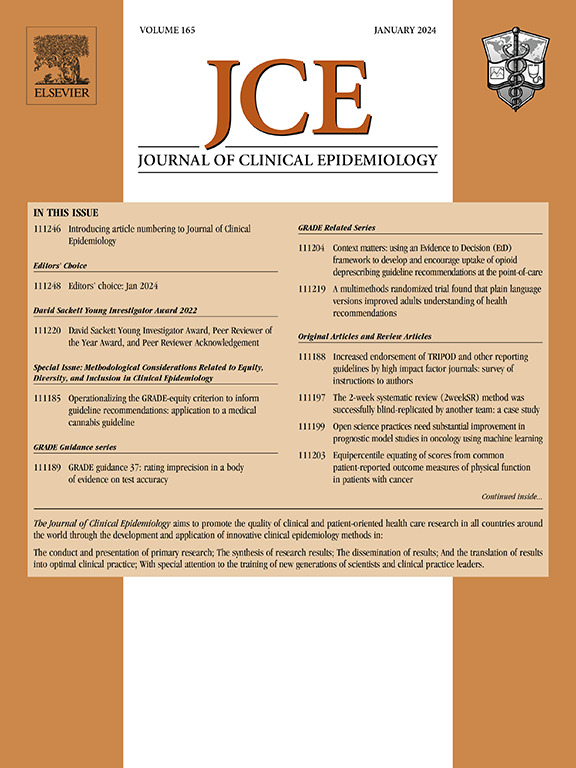GRADE Notes 4:"无 "证据时如何使用 GRADE?使用未公布登记数据的案例研究。
IF 7.3
2区 医学
Q1 HEALTH CARE SCIENCES & SERVICES
引用次数: 0
摘要
目标:值得信赖的指南有赖于对已发表的最佳证据进行系统回顾。GRADE 工作组为在缺乏已发表的直接证据的情况下制定循证建议提供了指导。在本文中,我们提供了一个案例,作为在收集专家证据之前利用登记册生成原始数据的替代解决方案:研究设计和环境:当缺乏直接发表的文献时,临床和统计专家团队可以利用登记册生成原始数据,从而回答临床上的重要问题:结果:在制定儿童腹膜透析相关感染预防和管理指南时优先考虑的 54 个问题中,有 25 个问题没有相关证据。利用未发表的登记数据作为主要信息来源,回答了 25 个问题中的 12 个,并为至少有一项已发表研究的 9 个问题提供了补充信息:本文扩展了我们之前针对 "无 "证据情况的 GRADE 说明,强调了在相关登记处和资源允许的情况下,利用未发表的登记处数据生成主要证据的价值。这种方法在处理罕见病症或被认为是易感人群的病症时具有特殊价值,同时强调了在报告未发表的工作时,原始数据报告和分析计划透明化的重要性。本文章由计算机程序翻译,如有差异,请以英文原文为准。
GRADE Notes 4: how to use GRADE when there is “no” evidence? A case study of using unpublished registry data
Objectives
Trustworthy guidelines rely on systematic reviews of the best available published evidence. The GRADE (Grading of Recommendations Assessment, Development, and Evaluation) Working Group has provided guidance about developing evidence-based recommendations when published direct evidence is lacking. In this article, we provide a case example as an alternate solution to generate primary data using registries prior to collecting expert evidence.
Study Design and Setting
When direct published literature was absent, a team of clinical and statistical expertise can utilize registries, when available, for primary data generation in a way that allows for answering clinically important questions.
Results
Out of 54 questions prioritized by a guideline development for the prevention and management of peritoneal dialysis-associated infections in children, 25 questions had no evidence to inform them. The use of unpublished registry data served as a primary source of information to answer 12 of the 25 questions and provided additional information for nine questions for which at least one published study was available.
Conclusion
This article extends our previous GRADE note for scenarios of “no” evidence, highlighting the value of generating primary evidence using unpublished registry data when relevant registries and resources allow. This approach can be of particular value when addressing conditions that are rare or from populations that are considered vulnerable, while emphasizing the importance of being transparent regarding the reporting of raw data and the analysis plan in the event of reporting unpublished work.
求助全文
通过发布文献求助,成功后即可免费获取论文全文。
去求助
来源期刊

Journal of Clinical Epidemiology
医学-公共卫生、环境卫生与职业卫生
CiteScore
12.00
自引率
6.90%
发文量
320
审稿时长
44 days
期刊介绍:
The Journal of Clinical Epidemiology strives to enhance the quality of clinical and patient-oriented healthcare research by advancing and applying innovative methods in conducting, presenting, synthesizing, disseminating, and translating research results into optimal clinical practice. Special emphasis is placed on training new generations of scientists and clinical practice leaders.
 求助内容:
求助内容: 应助结果提醒方式:
应助结果提醒方式:


